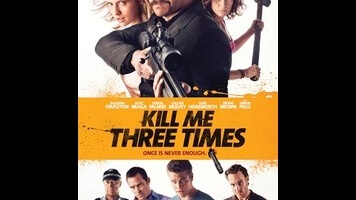Simon Pegg can’t bring humanity to the hit man nonsense of Kill Me Three Times

There’s no real reason for a hit man to dress in an all-black ensemble. The clothes don’t help him blend in with his surroundings, especially when said hit man works in sun-kissed coastal Australia and carries a gigantic and unmissable sniper rifle, which eliminates the need for much face-to-face intimidation anyway. Black-on-black clothing only functions as a statement: I am a cool professional hit man in a movie. Kill Me Three Times, the latest movie to indulge this cliché, doesn’t even trust its own visual shorthand, forcing Simon Pegg, playing the hit man in question, to refer to himself as a “professional,” like so many professional hit men in movies before him.
Pegg’s hit man spends much of Kill Me Three Times lurking on the sidelines, watching from a safe distance as a dentist (Sullivan Stapleton) and his wife (Teresa Palmer) plot to kidnap Alice (Alice Braga), the wife of a brute (Callan Mulvey), and collect some insurance money. Eventually, minor figures like well-meaning Dylan (Luke Hemsworth, expanding the Hemsworth family’s line of acting products to include noir patsies) and a crooked cop (Bryan Brown) enter the fray; the surfeit of characters explains why Pegg receives an “and” credit despite opening and closing the movie. Attempting to organize their cast and noir tropes, the filmmakers structure the story as a triptych with named sections (“Kill Me Once,” etc.); the second section, in particular, skips back in time to fill in blanks from the first. The film owes some of its failure, then, to the two-decade-old success of Pulp Fiction: Beyond the narrative double-back, Pegg’s indefatigable hit man is named Wolfe and Johnny Klimek’s score piles on the surfy guitar music. But it’s too listless to even qualify as a proper Tarantino knockoff, and each faux-retro strum on the soundtrack starts to feel like a burden.
It’s tempting to say that only a time-scrambling gimmick supplies the plot with any interest, but even that backhanded compliment implies greater structural integrity than Kill Me Three Times actually possesses. In this particular case, the gimmick doesn’t support a plodding story so much as the plodding story props up a semi-interesting gimmick. And when the narrative trickery ends, around the halfway mark, the movie continues to plod. All told, it spends a lot of time observing a group of bad and largely incompetent people endeavor to violently screw each other over. One of the few characters who resembles a rooting interest spends the middle hour of this 90-minute movie wandering around in a mostly offscreen haze.
Plenty of noir-like stories operate this way, placing various criminals and lowlifes on a collision course with each other. The best versions offer a point of view—weary fatalism, punishing morality, mordant slapstick, etc. Kill Me Three Times goes for none of the above, instead trying to turn repetitions into signatures: The running gag of a hit man’s cell phone having a cheery ringtone; the way the camera occasionally, inexplicably turns on its side for a shot; squib-heavy bursts of violence. It’s certainly uniform, in the sense that all of it radiates self-conscious smugness that obscures any humanity the actors might bring to the proceedings. Director Kriv Stenders seems to think he’s spun a twisty, delightfully amoral genre riff. Instead, he’s made a brightly colored smirk noir.